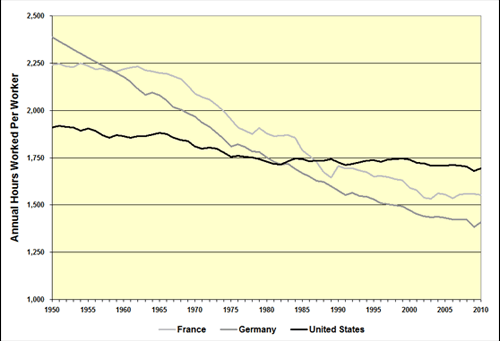
Work Time Choice
is a Success
Work Time Choice: Model Policies
Work Time Choice Is a Success
Workers in Germany and the Netherlands already have the right to choose part-time work.
Both of these countries have economies that are at least as successful as the United States. They are proof that work-time choice can be a success.
American and European Work Hours
Work hours have declined in western Europe generally since the end of World War II, but have hardly declined at all in the United States, as we can see in the following graph.
Work Hours in France, Germany and the United States
Source: Groningen University Total Economy DatabaseAverage American work hours were much shorter than Germany's and France's in 1950, but now are much longer. In fact, the United States has the longest work hours of any advanced industrial nation, according to the OECD.
Even the slight decline in American work hours shown on this graph is exaggerated, because these international statistics are based on surveys of how many hours of work the average job requires:
- The graph shows that American work hours dropped by a small amount from 1965 to 1980, but this was when large numbers of women were entering the work force, and many of them wanted part-time jobs. The average job took fewer hours because more people had jobs.
- The graph shows that work hours dropped a bit after 2000, but this graph does not show that it became more common for Americans to work multiple jobs after 2000, in response to stagnant wages during this decade.
Household surveys that look at the average number of hours worked per worker (rather than the hours per job in the graph) show that our work hours have actually risen by 204 hours per year since 1973.
Which Is More Successful?
It is interesting to contrast the United States and Germany, because the difference in work hours accounts for almost all of their difference in per capita output. The average German worker works 83% as many hours as the average American worker, and Germany's per capita GDP is 81% of America's.
Our conventional economic thinking implies that Germans would be better off working as much as Americans and bringing their income up to our level.
But Germans think they are better off having the extra time rather than the extra income. They seem to enjoy the minimum paid four-week vacations and the 9 to 13 days of public holidays per year that their laws guarantee. (29% of American workers have no paid vacations at all, and those who get paid vacations average just over one week per year.)
| Germany | United States | |
|---|---|---|
| Per Capita GDP (2010 PPP Dollars) | $37,366.57 |
$46,697.35 |
| Annual Hours per Worker | 1,408 |
1,695 |
| Unemployment (2010) | 7.2% |
9.6% |
| National Debt (% of GDP, 2010) | 83.96% |
94.36% |
| Household Savings Rate (2007-2010) | 11.3% |
4.8% |
| Trade Balance (Millions of 2010 Dollars) | 184,693 surplus |
470,898 deficit |
| Life Expectancy at Birth | 80 |
78 |
| Infant Mortality (Deaths per 1000 live births) | 4 |
7 |
| Educational Achievement (PISA Science Score, 2000) | 515.6 |
488.9 |
| Ecological Footprint (Global Hectares per Person) | 5.08 |
8.00 |
Comparing Germany and the United States
According to other common measures of economic success, German workers are better off than Americans, as we can see in the table above:
- Unemployment: Germany has had lower unemployment than the United States during the current hard economic times, in part because they have a policy called Kurzarbeit (short work), which uses unemployment insurance to subsidize employers who cut workers to part time rather than laying workers off during recessions, sharing the available work.
- Savings and Debt: Germany has a lower national debt and a much higher household savings rate than the United States: It seems that our work-and-spend economy leaves us less able to save than they are, even though we earn more money than they do.
- International Competitiveness: Germany also has perennial trade surpluses (over $184 billion in 2010), while the United States has perennial trade deficits (over $470 billion in 2010), showing that choice of work hours does not make a country less competitive economically.
- Well-Being: Germany is also better off than the United States according to common measures of social well-being: They have higher life expectancy and much lower infant mortality, and they have higher educational achievement than we do.
Americans do not seem to get much benefit from consuming more than Germans, but that extra consumption does increase our environmental impact. The ecological footprint of the average American is 8 global hectares, while the ecological footprint of the average German is 5.08 global hectares. Their footprint will become much smaller, because they plan to generate all of their electricity using renewable resources by 2050.
Though Germany is famous for its laws promoting clean energy and recycling, their shorter work hours currently contribute about as much as their cleaner economy to their smaller ecological footprint.

Follow Us
